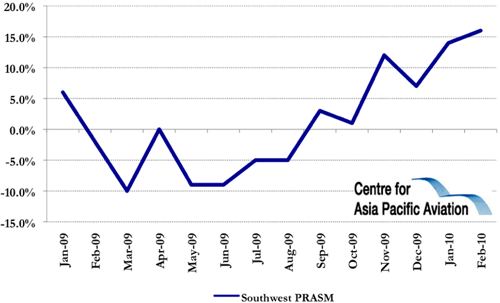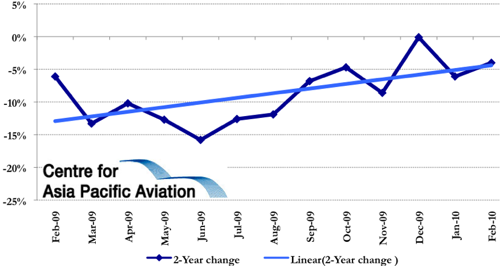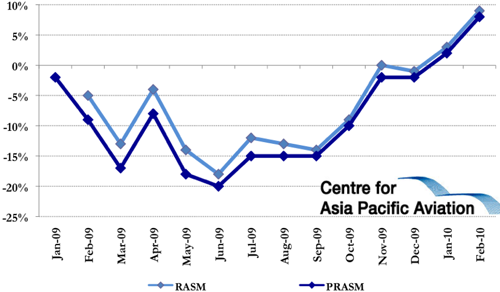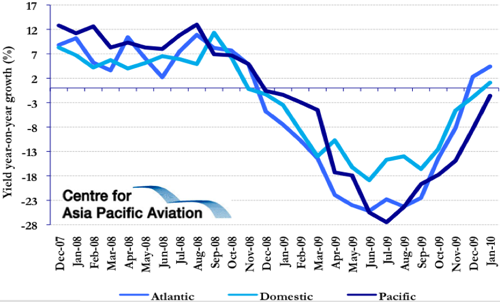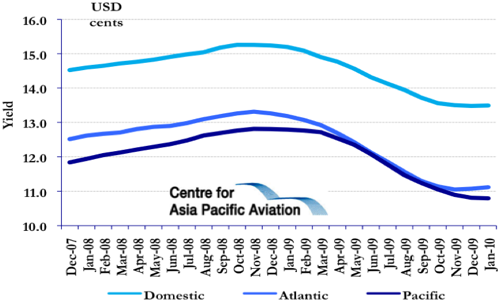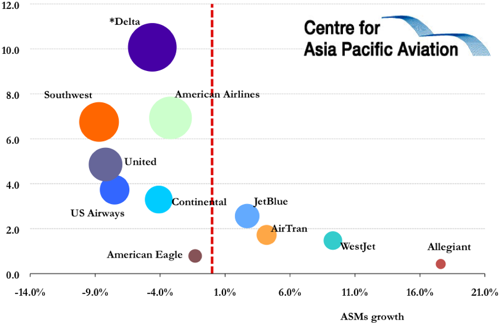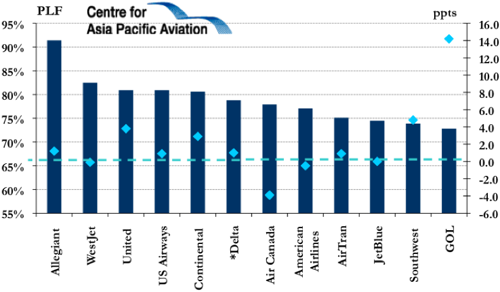Southwest and United Airlines report impressive PRASM performance. JetBlue improving
Southwest, the star performer in improving its unit revenues in recent months, continued to trump JetBlue, Continental Airlines and US Airways in this metric in Feb-2010, and was joined by United Airlines in reporting double-digit PRASM growth in the month.
Encouragingly, all the US carriers reporting monthly unit revenue figures registered growth in the month, with AirTran and Allegiant, which do not provide such updates, separately commenting of "improved" conditions in the market.
The lucrative business market, while recovering, is yet to return to pre-crisis levels, maintaining the pressure on the profitability and revenue outlook. The unit revenue figures were also inflated in the month, due to weather-related cancellations, which resulted in significant cancellations (and capacity reductions) across the US domestic network. See related article: Weather costs keep on mounting for US airlines
US airline unit revenue highlights: Feb-2010
|
|
PRASM |
RASM |
|---|---|---|
|
Southwest (Estimated) |
+16% to +17% |
n/a |
|
United Airlines (Estimated) |
+17% to +19% |
n/a |
|
US Airways (Estimated) |
+8% |
+9% |
|
Continental (Estimated) |
+7.5% to +8.5% |
+5.5% to +6.5% |
|
JetBlue (Estimated) |
+1% to +3% |
Sixth consecutive month of PRASM growth for Southwest
Southwest Airlines stated passenger revenue per ASM for Jan-2010 is estimated to have surged 16-17% in Feb-2010 - its largest PRASM increase in the past 12 months and the sixth consecutive month of PRASM growth for the carrier. The increase compares to a 2.0% PRASM reduction in Feb-2009.
Southwest PRASM year-on-year increase: Jan-2009 to Feb-2010
Looking forward, Southwest stated that with "strong revenue and booking trends continuing thus far into 2010, we expect another year-over-year increase in unit revenue for 1Q2010".
Year-on-year PRASM improvement in Feb-2010 for JetBlue, following nine months of PRASM reductions
JetBlue reported a 2% reduction in PRASM in Jan-2010 (off last year's positive base of +13.1%), for its first month of PRASM improvements since Apr-2009. On a 12-month moving average, JetBlue's PRASM finally showed signs of stabilisation last month.
JetBlue PRASM year-on-year increase and 12 month moving average: Apr-2008 to Feb-2010
Looking ahead to 2010, JetBlue expects PRASM and RASM to be in the range of down 1-2% in 1Q2010, but some solid improvement thereafter. JetBlue is forecasting PRASM and RASM for the full year to increase in the +5-8% range.
AirTran seeing "improving" yield trends
Also among the LCCs, AirTran Airways (which does not provide monthly yield updates), at the Raymond James Institutional Investors Conference on 08-Mar-2010, commented that there is a "favourable industry backdrop going forward", with capacity remaining "disciplined" and yield trends "improving".
During 1Q2010, total unit revenues are up in the 3.5-4.5% range, with double-digit improvements expected in Mar-2010 and into 2Q2010. The carrier previously stated that it expected total unit revenues in 1Q2010 to be up in the 2.5-3.5% range, indicating an improvement in the yield environment.
Allegiant seeing RASM improvement in Feb-2010
At the same conference, Allegiant Air added that it was expecting a 4% RASM improvement in Feb-2010, with a 2% increase in TRASM and a 7% upward movement in the total fare (like AirTran, Allegiant does not provide monthly yield/unit revenue updates).
During 2009, Allegiant reported double-digit reductions in total revenue per ASM and average scheduled service fares, of 10.3% and 17.2%, respectively, to USD 10.28 cents and USD70.38, respectively. Average fare declined 9.6% to USD103.45 in the year (the carrier benefited from a 12.4% increase in ancillary average fare to USD33.07).
United Airlines reports largest PRASM improvement in over two years
Among the network carriers, United Airlines reported an estimated increase in consolidated passenger revenue per available seat mile (PRASM) of 17.0% to 19% in Feb-2010, for the third consecutive month of improvements and the largest year-on-year rise since prior to Jan-2008.
Consolidated PRASM is estimated to have increased by 3.8% to 5.8% from Feb-2010 levels, of which 2.0 ppts is attributable to growth in ancillary revenues.
United Airlines PRASM growth (%): Jan-2008 to Feb-2010
With two consecutive months of double-digit RASM, United Airlines is headed for its first quarter of positive RASM growth in over four quarters.
United Airlines consolidated PRASM developments: 1Q2008 to 4Q2009
|
USD cents |
Consolidated PRASM |
Year-on-year growth |
|---|---|---|
|
1Q2008 |
11.09 |
+8.3% |
|
2Q2008 |
12.39 |
+3.9% |
|
3Q2008 |
13.02 |
+5.2% |
|
4Q2008 |
11.96 |
+2.1% |
|
1Q2009 |
9.86 |
-11.1% |
|
2Q2009 |
10.26 |
-17.2% |
|
3Q2009 |
11.10 |
-14.7% |
|
4Q2009 |
11.34 |
-5.2% |
Continental Airlines' unit revenues improve - best PRASM performance since Dec-2008
Continental reported an encouraging set of traffic results for Feb-2010, with its first month of positive unit revenue growth since Dec-2008. During Feb-2010, consolidated passenger revenue per available seat mile (RASM) is estimated to have increased between 7.5% and 8.5%, while mainline RASM is estimated to have increased between 5.5% and 6.5%.
For Jan-2010, Continental Airlines confirmed that consolidated passenger RASM decreased by 1.3%, which was within the carrier's expectations of a 1.0% to 2.0% reduction, while mainline passenger RASM decreased by 2.8% - on the lower end of the carrier's estimates of a 2.5% to 3.5% reduction.
However, the carrier explained that the combination of capacity (ASMs) reductions caused by the two February snowstorms and the company's re-accommodation of passengers impacted by flight cancellations resulted in a year-on-year RASM benefit of approximately 1 ppts compared to normal levels. The Feb-2010 RASM growth also comes off a negative base in Feb-2009 (-11.5%).
Continental Airlines consolidated PRASM (US cents per ASM): Feb-2008 to Feb-2010
Looking at a two-year range, Continental's Jan-2010 PRASM decreased 4.6% over Feb-2008.
Continental Airlines' consolidated PRASM growth (two year range): Feb-2009 to Feb-2010
US Airways seeing "encouraging revenue momentum"
US Airways President, Scott Kirby, stated that the carrier's consolidated (mainline and Express) PRASM increased by approximately 8% in Feb-2010, while total revenue per ASM increased by approximately 9% in the month.
Mr Kirby added that the results indicate that the "revenue environment continues to show material signs of improvement with corporate booked revenue up more than 35% on a year-over-year basis."
US Airways' RASM and PRASM growth (%): Jan-2009 to Feb-2010
ATA reports improved passenger revenue in Jan-2010 after the largest drop on record in 2009
2009 was an extremely challenging year for US airlines, with passenger revenue declining 18% year-on-year in the full year, as a result of a 6% reduction in passenger volume and a 13% drop in the average price paid to fly one mile. The decline in passenger revenue from 2008 to 2009 was the largest on record, exceeding the 14% decline observed from 2000 to 2001.
ATA yield growth: Dec-2007 to Jan-2010
However, yields strengthened towards the end of 2009, with the Air Transport Association of America (ATA) reporting a 1.4% increase in passenger revenue in Jan-2010, reversing 14 consecutive months of declines. The average price to fly one mile also increased (up 0.6%), for the first such increase since Nov-2008. On a 12-month moving average, yields also appear to have stabilised in key markets.
ATA yield: 12 months moving average
US network carriers' occupancy levels higher than their LCC counterparts
Meanwhile, all but two of the nine US majors (with the exception of American Airlines and JetBlue, which reported a marginal load factor reduction of 0.5 ppts and a stable load factor, respectively) reported load factor improvements in Feb-2010, reflecting continued capacity reductions.
During the month, the nation's six largest airlines all reported capacity reductions, with only JetBlue and AirTran and Allegiant reporting capacity increases (up by under 6%) among the nation's nine largest airlines).
North American carriers' domestic passenger capacity growth (% change year-on-year): Feb-2010
Load factors among the major US airlines were strong in the month, in the 77% to 81% range, while load factors among the LCCs ranged from 74% to 75%. The US network carriers have pared back capacity so much that they are now consistently operating with higher load factors than their point-to-point LCC competitors.
US airlines domestic traffic^ highlights: Feb-2010
|
|
Traffic (RPMs) (bill) |
% Change |
Capacity (ASMs) (bill) |
% Change |
Load factor (%) |
% Change |
Traffic - pax (mill) |
% Change |
|---|---|---|---|---|---|---|---|---|
|
Delta/Northwest |
7.9 |
-3.3% |
10.1 |
-4.6% |
78.8% |
+1.0 ppts |
n/a |
n/a |
|
5.3 |
-3.9% |
6.9 |
-3.2% |
77.1% |
-0.5 ppts |
n/a |
n/a |
|
|
5.0 |
-2.9% |
6.8 |
-8.7% |
73.9% |
+4.8 ppts |
7.0 |
-1.5% |
|
|
United * |
3.9 |
-3.8% |
4.9 |
-8.2% |
80.9% |
+3.8 ppts |
n/a |
n/a |
|
3.0 |
-6.6% |
3.7 |
-7.5% |
80.9% |
+0.9 ppts |
3.2 |
-6.3% |
|
|
2.7 |
-0.5% |
3.3 |
-4.1% |
80.6% |
+2.9 ppts |
n/a |
n/a |
|
|
1.9 |
+2.7% |
2.6 |
+2.7% |
74.5% |
- |
1.6 |
+0.1% |
|
|
AirTran |
1.3 |
+5.4% |
1.7 |
+4.2% |
75.1% |
+0.9 ppts |
1.6 |
+0.4% |
As is usually the case, Southwest's load factors remained the weakest among the major US airlines in Feb-2010, but the LCC is working hard in this area. Southwest's load factors, in the month, rose 4.8 ppts, for the largest load factor gain among the US airlines.
Select US airline load factor (%) and load factor growth (ppts): Feb-2010
Improved outlook for 2010
The outlook for 2010 is more optimistic, with ATA President and CEO, James C May, commenting that the "modest uptick in passenger revenue and the solid increase in cargo volumes are promising signs that air transport demand may be at the beginning of a long-awaited recovery". He previously commented that "anecdotal evidence suggests a positive revenue trajectory in 2010".
However, while there is cause for optimism with signs that there exists positive revenue trajectory for the year ahead, as previously noted by ATA VP and Chief Economist, John Heimlich, it is "important to remember that 'better than 2009 is not saying a whole lot' in the grand scheme".
